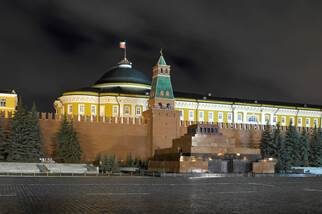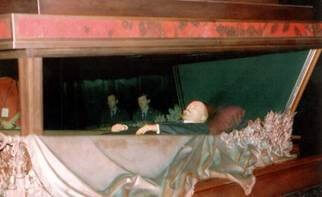VIII. Release from Morality
Why are institutions that produce extraordinary violence—such as that of war—more-or-less taken for granted as elements of society? When an individual acting on his own kills large numbers of human beings, we call him a mass-murderer and are astonished that he could perform such an act. This person is morally condemned, and often assumed to be suffering from a mental disorder.
On the other hand, when an individual kills large number of people in the name of the society he represents, we take an entirely different stance. If killing is undertaken by a member of our society—for example by a soldier who fires a machine-gun or a pilot who drops a bomb—we attach positive moral valence to this act. We assume that his behavior is justified and justifiable.
 |
 |
| Lenin’s Mausoleum at Night (2007) |
The Mummy’s Tomb |
|
Fascist and communist dictatorships were headed by flesh-and-blood “incarnations of the old-time ‘king by divine right’.” Men like Lenin, Hitler, Stalin and Mao stood at the center of their respective societies and—like Pharaohs—required absolute obedience to their commands and whims. |
|
Historians study specific episodes of political violence. Looking at the sequence of events that lead to a particular war, the assumption is that each case has a separate, distinct cause. I hypothesize that a broader dynamic is at work; that the tendency of societies to perform acts of violence is inherent in the nature of the state.
What is it about the domain of politics that releases people from ordinary moral strictures and structures? Why—in the domain of politics—is everything permitted? Why—within this sphere—are extraordinary acts of brutality considered to be normative?
What occurs as “history” is felt to be beyond good-and-evil, transcending ordinary human existence. Within this domain, standards used to judge other spheres of existence are not applicable. Societies that engage in murderous acts of war may not be considered immoral. What is the nature of the political domain that makes it immune from ordinary moral standards?
One may hypothesize that human beings have created politics as a unique domain precisely to establish a place where people can be released from laws and conventional forms of behavior. Within this privileged sphere, human being are allowed to commit acts of mass-murder.
When waging war, human beings shoot one another, blow each other up, torture one another, drop bombs on cities and murder thousands of people. Yet these events are not considered unusual or abnormal. They are reported in newspapers and recorded in history books. By virtue of having been reported and recorded, these forms of behavior are rendered normative. They become the stuff of ordinary life. This is how things are.
IX. Twentieth Century Pharaohs
Lewis Mumford traces the extraordinary violence of the Twentieth Century to the model or ideology established at the beginning of civilization, which revolved around the extreme centralization of political power in the person of tyrants, despots and kings—who exerted unqualified command over private wealth by taxation, expropriation, and conquest. Out of this personal sovereignty of the king by divine right rose the impersonal sovereignty of the state.
The “megamachine” refers to the system that allowed powerful leaders to command and direct large numbers of men in concerted effort. The megamachine, Mumford explains, is not a mere administrative organization, rather is a machine in the orthodox sense: a combination of interchangeable parts designed to perform standardized motions and repetitive work.
The prototype of the megamachine was the laborers of Egypt who came together to build the Pyramids. Commanded by the Pharaoh and his court, men from all parts of the Egyptian state—like soldiers in an army—united to create a gigantic monument. Civilization, Mumford says, evolved out of the capacity for a central agent or agency to direct and command the work of tens-of-thousands of men. Only by virtue of such concerted efforts could “big” projects—like the building of a pyramid—be accomplished.
Warfare was another project requiring the assemblage of the megamachine. To keep the threat of war constantly in existence, Mumford observes, is the surest way to hold the “otherwise autonomous or quasi-autonomous components together as a functioning working unit.” To this day, the threat of war allows political leaders to conscript members of society.
Mumford argues that Twentieth Century totalitarian societies operated according to the same dynamic that drove ancient Near Eastern societies. Fascist and communist dictatorships were headed by flesh-and-blood “incarnations of the old-time ‘king by divine right’.” Men like Lenin, Hitler, Stalin and Mao stood at the center of their respective societies and—like Pharaohs—required absolute obedience to their commands and whims.
According to Mumford, there is no component of the modern megamachine that did not exist “in fact or in dream” in the original model. The ancient and modern megamachines have similar technological capacities. They are systems of organization capable of performing tasks that lie “outside the range of small-work collectives and loose tribal or territorial groups.”
The difference between the ancient and modern megamachines is the level of technology that can be put at the disposal of the latter. What is distinctly modern, Mumford explains, is the effective “materialization of archaic dreams” that hitherto had been technologically impractical. What were once impossible wishes, vain hopes and empty boasts in the mouths of ancient gods and kings have now become actualities, and herald even more “wanton expansions of irresistible power and unrestrained irrationality.”
Writing during the nuclear competition between the United States and Soviet Union, Mumford in The Pentagons of Power (1970) states what the ancient and modern megamachines have in common is that each ignores the needs and purposes of life in order to “fortify the power complex and extend its dominion.” Both megamachines, Mumford says, are “oriented toward death.”
The project of building pyramids may be understood as a form of death-in-life, that is, a project in which life is devoted to overcoming death. Builders of Pyramids toiled their entire lives at back-breaking labor for the sake of bringing a monument into the world—whose only purpose was to assure the immortality of the Pharaoh. The wealth of Egypt and energy of its people were siphoned off into building these dead things.
In the Twentieth Century, energy & wealth were siphoned off to support ideologies that promised immortality. Hitler dreamt of a “thousand year Reich.” Lenin, Stalin and Mao embraced the ideology of communism that—they imagined—would come to dominate the world. What do we have to show for these ideologies now?
Mumford discusses new forms of the Pyramid complex, e. g., skyscrapers, atomic reactors, nuclear weapons, superhighways and space rockets. These contemporary megalithic structures “reproduce all the features of the ancient form of Pyramid building on an even larger scale.” Mumford says that our attachment to the modern megamachine possesses the quality of a religion.
Just as static physical structures supported the worshipper’s belief in the validity of Pharaoh’s claim to divinity and immortality, so Mumford says do contemporary megalithic projects equally “validate and exalt the new religion.” More broadly, we may suggest, people in the Twentieth and Twenty-First centuries worship and are devoted to the idea of the nation-state.
Nation-states rest at the heart of modern societies, capable of mobilizing human energy and material resources on a vast scale. The most extreme form of national mobilization occurs when a nation goes to war. Mumford says that the institution of war represents a “special form of social organization” that grew out of the Egyptian and Mesopotamian communities of the pyramid age.
During times of war, the megamachine rolls into action (see “War is the Health of the State”, Randolph Bourne, 1918). Leaders can call upon hundreds-of-thousands of human beings. Factories produce guns, bullets, tanks, artillery shells, aircrafts, bombs and military uniforms. Soldiers may be required to go into battle—and to die. Warfare constitutes the state in all its glory.
Mumford hypothesizes that the dynamic that he uncovered at the heart of ancient civilization also governed the massive destructiveness of the Twentieth Century. In each case, a single individual—at the center of society—was granted enormous power and the capacity to compel absolute obedience.
Only belief in the divinity of the king and willingness to unconditionally obey his orders, Mumford says, could bring forth the unified efforts required for large-scale projects such as building Pyramids. Some of these projects—such as building dams for irrigation—were extremely beneficial to human beings; other large-scale projects produced no concrete benefits.
In the Twentieth Century, higher levels of technical performance allowed the megamachine's capacity to inflict destruction and death to be both “expanded and speeded up.” Writing about the nuclear competition between the United States and Soviet Union, Mumford observes that no human purpose was served by the modes of extermination that were developed.
The development of nuclear weapons demonstrated the “deep underlays of psychotic irrationality” upon which fantasies of absolute weapons, power and control were laid. Compared with the pervasive dedication to death in our own culture, Mumford says, the Egyptian cult of the dead—with its magniloquent pyramids, magic rituals, and elaborate techniques of mummification—was a “relatively innocent exhibition of irrationality.”
The democratic revolutions of the last 200 years represent a reaction against the tendency to endow political leaders with absolute power. The French and American revolutions sought to liberate people from the idea of the “divine king.” Yet the inclination of people to believe that certain individuals possess extraordinary powers—and to seek to connect with these powerful people—remains fundamental.
This mechanism took on an extreme form in totalitarian societies that dominated the Twentieth Century. People like Lenin, Stalin, Hitler, Mussolini and Mao were imagined to constitute the center of their respective societies. Like divine Kings, they were granted absolute power, and therefore were able to generate monumental destruction.
I suggest that the psychic mechanism that compels us to link ourselves with political leaders today is the same mechanism that generated attachment to Pharaohs during the time of the Pyramids. In each instance, some extraordinary force or power is imagined to emanate from a place in society outside the self. This place—separate from one’s personal, private life—is conceived as the center of society.
Of course, leaders at the center have power only because of their relationship to a nation. Rudolf Hess often declared, “Hitler is Germany, just as Germany is Hitler.” Hitler’s extraordinary power was based on the fact that he embodied or symbolized the German nation. Just as Pharaohs derived their power by virtue of their relationship to a god, so do leaders in the modern world derive power by virtue of their relationship to a nation.
The Pharaoh required obedience—used the energy of the Egyptian people to build a pyramid. Similarly, Hitler demanded the obedience of his people—asking them to wage war in the name of Germany. What each case has in common is that human beings are required to subordinate their own lives to an object or entity conceived as greater and more significant than the life of the individual.
Hitler declared to the German people, “You are nothing, your nation is everything.” Leaders in Egyptian society might have said, “You are nothing, the Pharaoh is everything.” Or: “Your existence is insignificant—except as you devote your life to building a pyramid.” In each instance, human beings are asked to devote themselves absolutely to an object outside the self-conceived as omnipotent. This is what “sacrifice” means.
Like the Pharaohs, Hitler relished the creation of monumental architectural works. His building projects, Hitler said, were designed to “strengthen the National Socialist state.” Since we believe in the eternity of this Reich,” Hitler proclaimed, therefore “these works of ours shall also be eternal.” Buildings would be a symbol of the eternity of the Reich, that is, of a “people which lives forever.”
What the Pharaohs and Hitler had in common was their devotion to a fantasy of immortality. Human existence was devoted to sustaining this fantasy. The lives of individual human beings were sacrificed in the name of supporting this fantasy. |